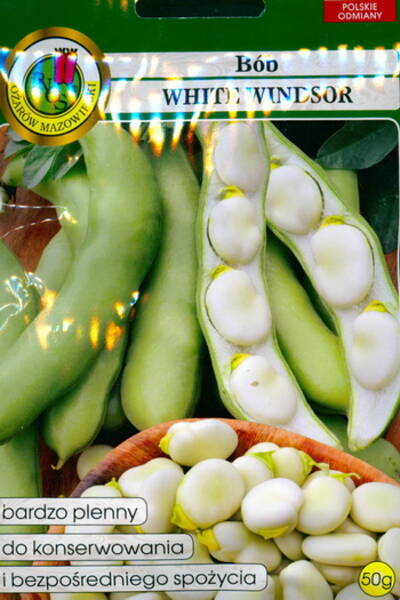Your shopping cart is empty!
Broad bean "White Windsor" (500,0 g)
Broad bean "White Windsor" - Vicia faba L.
Mid-season, high-yielding variety. The beans are wide, the seeds are large, flat, greenish white, very tasty. It is intended for fresh consumption or culinary processing of dry seeds.
The culture is cold-resistant, demanding on soil and air moisture.
Sowing from late April to early May, pre-soaked seeds, planting depth - 4 cm. The best soils are loamy, well cultivated and fertilized.
Care: loosening the soil, hilling plants, removing weeds. In arid conditions, watering is necessary, at the end of flowering, pinching of the tops is carried out.
Sowing pattern: 20 x 15 cm.
1,0 g = 1-2 seeds
Agricultural technology: beans grow well on loamy, clayey, slightly acidic soils with sufficient moisture.
The best precursors to beans are cabbage, potatoes, pumpkin seeds, and various root vegetables. The soil for the beans is dug in the fall on the bayonet of a shovel.
Humus, mineral fertilizers are introduced. Before sowing, the seeds are soaked for 2-4 hours in water.
Then the seeds are sown into moist soil to a depth of 6-8 cm using a belt method with a distance of 50-60 cm between ribbons and 25-30 cm between rows in a ribbon.
The distance between plants in a row is 3-5 cm. Further care of plants consists in loosening, regular feeding, light hilling and watering in dry weather.
At the beginning of mass flowering, the tops of the shoots are cut off. This promotes uniform ripening of the beans and is a means of fighting black bean aphids.
The beans are harvested in several stages: at the stage of milk ripeness of the grain, and for winter consumption, fully ripe beans are harvested.
The flowers are white with dark spots on the wings. Productivity up to 1.5 kg / sq.m.
They contain up to 6% proteins. Green beans contain a lot of vitamin B, PP, carotene (up to 2.5%).
Resistance: Cold resistant.
Usage: for home cooking and canning.
Mid-season, high-yielding variety. The beans are wide, the seeds are large, flat, greenish white, very tasty. It is intended for fresh consumption or culinary processing of dry seeds.
The culture is cold-resistant, demanding on soil and air moisture.
Sowing from late April to early May, pre-soaked seeds, planting depth - 4 cm. The best soils are loamy, well cultivated and fertilized.
Care: loosening the soil, hilling plants, removing weeds. In arid conditions, watering is necessary, at the end of flowering, pinching of the tops is carried out.
Sowing pattern: 20 x 15 cm.
1,0 g = 1-2 seeds
Agricultural technology: beans grow well on loamy, clayey, slightly acidic soils with sufficient moisture.
The best precursors to beans are cabbage, potatoes, pumpkin seeds, and various root vegetables. The soil for the beans is dug in the fall on the bayonet of a shovel.
Humus, mineral fertilizers are introduced. Before sowing, the seeds are soaked for 2-4 hours in water.
Then the seeds are sown into moist soil to a depth of 6-8 cm using a belt method with a distance of 50-60 cm between ribbons and 25-30 cm between rows in a ribbon.
The distance between plants in a row is 3-5 cm. Further care of plants consists in loosening, regular feeding, light hilling and watering in dry weather.
At the beginning of mass flowering, the tops of the shoots are cut off. This promotes uniform ripening of the beans and is a means of fighting black bean aphids.
The beans are harvested in several stages: at the stage of milk ripeness of the grain, and for winter consumption, fully ripe beans are harvested.
The flowers are white with dark spots on the wings. Productivity up to 1.5 kg / sq.m.
They contain up to 6% proteins. Green beans contain a lot of vitamin B, PP, carotene (up to 2.5%).
Resistance: Cold resistant.
Usage: for home cooking and canning.
Eng.: Broad beans. Bot.: Vicia faba L. var. major Harz.











